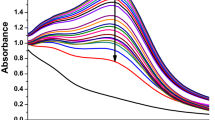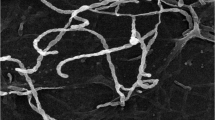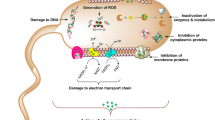Abstract
This study aims to describe the antibacterial and cytotoxic properties of a nanocomposite composed of silver chloride and silver nanoparticles (AgCl/Ag) biogenically synthesized using Arthrobacter sp., a non-pathogenic Antarctic soil bacterium. Spherical nanoparticles (hydrodynamic size of 42 nm) coated with biomolecules derived from Arthrobacter sp. were obtained. The antibacterial activity of the nanocomposite was demonstrated against Gram-positive and Gram-negative bacterial strains, including the multidrug-resistant Pseudomonas aeruginosa KPC 37. Furthermore, the cytotoxicity of AgCl/Ag nanocomposite was evaluated against the non-tumoral (Vero) and tumoral (SW-1353) cell lines. The nanocomposite was not cytotoxic to the Vero cells at concentrations below 150 μg/mL, whereas at concentrations above 25 μg/mL, a significant cytotoxic effect was observed for the SW-1353 cells. Interestingly, at 150 μg/mL, the nanocomposite demonstrated a potent antibacterial activity for all bacterial strains evaluated. To the best of our knowledge, this is the first report describing the green synthesis of AgCl/Ag nanocomposite by the bacterium Arthrobacter sp. isolated from Antarctic soil. The obtained nanocomposite may find important biomedical applications, with potent antibacterial and antitumoral effects and low toxicity to healthy cells.

.











Similar content being viewed by others
References
Kanmani, P., & Lim, S. T. (2013). Synthesis and structural characterization of silver nanoparticles using bacterial exopolysaccharide and its antimicrobial activity against food and multidrug resistant pathogens. Process Biochemistry, 48(7), 1099–1106.
Raza, M., Kanwal, Z., Rauf, A., Sabri, A., Riaz, S., & Naseem, S. (2016). Size- and shape-dependent antibacterial studies of silver nanoparticles synthesized by wet chemical routes. Nanomaterials, 6(4), 74.
Daneu, N., Baláz, L., Dutková, E., Tkác, L., Brianc, J., Zorkovská, A., & Baláz, P. (2017). Bio-mechanochemical synthesis of silver nanoparticles with antibacterial activity. Advanced Powder Technology, 28, 3307–3312.
Ratyakshi, & Chauhan, R. P. (2009). Colloidal synthesis of silver nano particles. Asian Journal of Chemistry, 21(10), 113–116.
Liu, C., Yang, D., Wang, Y., Shi, J., & Jiang, Z. (2012). Fabrication of antimicrobial bacterial cellulose-Ag/AgCl nanocomposite using bacteria as versatile biofactory. Journal of Nanoparticle Research, 14, 1084.
Tareq, F. K., Fayzunnesa, M., & Kabir, M. S. (2017). Antimicrobial activity of plant-median synthesized silver nanoparticles against food and agricultural pathogens. Microbial Pathogenesis, 109, 228–232.
Zhang, X.-F., Liu, Z.-G., Shen, W., & Gurunathan, S. (2016). Silver nanoparticles: synthesis, characterization, properties, applications, and therapeutic approaches. International Journal of Molecular Sciences, 17(9), 1534.
Trinh, N. D., Nguyen, T. T. B., & Nguyen, T. H. (2015). Preparation and characterization of silver chloride nanoparticles as an antibacterial agent. Advances in Natural Sciences: Nanoscience and Nanotechnology, 6(4), 45011.
Wang, X., Han, Q., Yu, N., Wang, T., Wang, C., & Yang, R. (2018). GO-AgCl/Ag nanocomposites with enhanced visible light-driven catalytic properties for antibacterial and biofilm-disrupting applications. Colloids and Surfaces B: Biointerfaces, 162, 296–305.
Ranoszek-Soliwoda, K., Tomaszewska, E., Socha, E., Krzyczmonik, P., Ignaczak, A., Orlowski, P., Krzyzowska, M., Celichowski, G., & Grobelny, J. (2017). The role of tannic acid and sodium citrate in the synthesis of silver nanoparticles. Journal of Nanoparticle Research, 19(8), 273.
Horikoshi, S., Sumi, T., & Serpone, N. (2013). A hybrid microreactor/microwave high-pressure flow system of a novel concept design and its application to the synthesis of silver nanoparticles. Chemical Engineering and Processing: Process Intensification, 73, 59–66.
Oyagi, M. O., Michira, I. N., Guto, P., Baker, P. G. L., Kamau, G., & Iwuoha, I. (2014). Polydisperse low diameter ‘non-toxic’ silver nanoparticles encapsulated by rooibos tea templates. Nano Hybrids, 8, 57–72.
Seabra, A. B., Manosalva, N., De Araujo Lima, B., Pelegrino, M. T., Brocchi, M., Rubilar, O., & Duran, N. (2017). Antibacterial activity of nitric oxide releasing silver nanoparticles. Journal of Physics: Conference Series, 838(1), 012031.
Raj, S., & Trivedi, R. (2018). Green synthesis and characterization of silver nanoparticles using Enicostemma axillare (Lam.) leaf extract. Biochemical and Biophysical Research Communications, 503(4), 2814–2819.
Seabra, A. B., Haddad, P., & Duran, N. (2013). Biogenic synthesis of nanostructured iron compounds: applications and perspectives. IET Nanobiotechnology, 7(3), 90–99.
Patil, M. P., & Kim, G. D. (2018). Marine microorganisms for synthesis of metallic nanoparticles and their biomedical applications. Colloids and Surfaces B: Biointerfaces, 172, 487–495.
Seabra, A. B., & Durán, N. (2015). Nanotoxicology of metal oxide nanoparticles. Metals, 5(2), 934–975.
Faghri Zonooz, N., & Salouti, M. (2011). Extracellular biosynthesis of silver nanoparticles using cell filtrate of Streptomyces sp. ERI-3. Scientia Iranica, 18(6), 1631–1635.
Kalishwaralal, K., Deepak, V., Ramkumarpandian, S., Nellaiah, H., & Sangiliyandi, G. (2008). Extracellular biosynthesis of silver nanoparticles by the culture supernatant of Bacillus licheniformis. Materials Letters, 62, 4411–4413.
Kumar, C. G., & Mamidyala, S. K. (2011). Extracellular synthesis of silver nanoparticles using culture supernatant of Pseudomonas aeruginosa. Colloids and Surfaces B: Biointerfaces, 84(2), 462–466.
Yumei, L., Yamei, L., Qiang, L., & Jie, B. (2017). Rapid biosynthesis of silver nanoparticles based on flocculation and reduction of an exopolysaccharide from arthrobacter sp. B4: Its antimicrobial activity and phytotoxicity. Journal of Nanomaterials, 2017 8 pages.
Santos, M. C., Seabra, A. B., Pelegrino, M. T., & Haddad, P. S. (2016). Synthesis, characterization and cytotoxicity of glutathione- and PEG-glutathione-superparamagnetic iron oxide nanoparticles for nitric oxide delivery. Applied Surface Science, 367, 26–35.
Gallardo, C., Monrás, J. P., Plaza, D. O., Collao, B., Saona, L. A., Durán-Toro, V., Venegas, F. A., Soto, C., Ulloa, G., Vásquez, C. C., Bravo, D., & Pérez-Donoso, J. M. (2014). Low-temperature biosynthesis of fluorescent semiconductor nanoparticles (CdS) by oxidative stress resistant Antarctic bacteria. Journal of Biotechnology, 187, 108–115.
Klaus-Joerger, T., Joerger, R., Olsson, E., & Granqvist, C. G. (2001). Bacteria as workers in the living factory: metal-accumulating bacteria and their potential for materials science. Trends in Biotechnology, 19(1), 15–20.
Lengke, M. F., Fleet, M. E., & Southam, G. (2007). Biosynthesis of silver nanoparticles by filamentous cyanobacteria from a silver(I) nitrate complex. Langmuir, 23(5), 2694–2699.
Chattopadhyay, M. K., Raghu, G., Sharma, Y. V. R. K., Biju, A. R., Rajasekharan, M. V., & Shivaji, S. (2011). Increase in oxidative stress at low temperature in an antarctic bacterium. Current Microbiology, 62(2), 544–546.
Shivaji, S., Madhu, S., & Singh, S. (2011). Extracellular synthesis of antibacterial silver nanoparticles using psychrophilic bacteria. Process Biochemistry, 46(9), 1800–1807.
Javani, S., Marín, I., Amils, R., & Abad, J. P. (2015). Four psychrophilic bacteria from Antarctica extracellularly biosynthesize at low temperature highly stable silver nanoparticles with outstanding antimicrobial activity. Colloids and Surfaces A: Physicochemical and Engineering Aspects, 483, 60–69.
Wang, J., Salem, D. R., & Sani, R. K. (2019). Extremophilic exopolysaccharides: a review and new perspectives on engineering strategies and applications. Carbohydrate Polymers, 205, 8–26.
Lamilla, C., Pavez, M., Santos, A., Hermosilla, A., Llanquinao, V., & Barrientos, L. (2017). Bioprospecting for extracellular enzymes from culturable Actinobacteria from the South Shetland Islands, Antarctica. Polar Biology, 40(3), 719–726.
Raju, R., Piggott, A. M., Barrientos Diaz, L. X., Khalil, Z., & Capon, R. J. (2010). Heronapyrroles A-C: Farnesylated 2-Nitropyrroles from an australian marine-derived Streptomyces sp. Organic Letters, 12(22), 5158–5161.
Rietveld, H. M. (1967). Line profiles of neutron powder-diffraction peaks for structure refinement. Acta Crystallographica, 22(1), 151–152.
Coelho, A. A., Evans, J., Evans, I., Kern, A., & Parsons, S. (2011). The TOPAS symbolic computation system. Powder Diffraction, 26(S1), S22–S25.
Gopinath, V., Priyadarshini, S., Meera Priyadharsshini, N., Pandian, K., & Velusamy, P. (2013). Biogenic synthesis of antibacterial silver chloride nanoparticles using leaf extracts of Cissus quadrangularis Linn. Materials Letters, 91, 224–227.
Kang, Y. O., Lee, T. S., & Park, W. H. (2014). Green synthesis and antimicrobial activity of silver chloride nanoparticles stabilized with chitosan oligomer. Journal of Materials Science: Materials in Medicine, 25(12), 2629–2638.
Anthony, K. J. P., Murugan, M., Jeyaraj, M., Rathinam, N. K., & Sangiliyandi, G. (2014). Synthesis of silver nanoparticles using pine mushroom extract: a potential antimicrobial agent against E. coli and B. subtilis. Journal of Industrial and Engineering Chemistry, 20(4), 2325–2331.
Alishah, H., Pourseyedi, S., Mahani, S. E., & Ebrahimipour, S. Y. (2016). Extract-mediated synthesis of Ag@AgCl nanoparticles using Conium maculatum seeds: characterization, antibacterial activity and cytotoxicity effect against MCF-7 cell line. RSC Advances, 6(77), 73197–73202.
Rolim, W. R., Pelegrino, M. T., de Araújo Lima, B., Ferraz, L. S., Costa, F. N., Bernardes, J. S., Rodigues, T., Brocchi, M., & Seabra, A. B. (2019). Green tea extract mediated biogenic synthesis of silver nanoparticles: characterization, cytotoxicity evaluation and antibacterial activity. Applied Surface Science, 463, 66–74.
Singh, H., Du, J., Singh, P., & Hoo, T. (2018). Extracellular synthesis of silver nanoparticles by Pseudomonas sp . THG-LS1 . 4 and their antimicrobial application. Journal of Pharmaceutical Analysis, 8(4), 258–264.
Li, S., Shen, Y., Xie, A., Yu, X., Qiu, L., Zhang, L., & Zhang, Q. (2007). Green synthesis of silver nanoparticles using Capsicum annuum L. extract. Green Chemistry, 9(8), 852–858.
Saifuddin, N., Wong, C. W., & Yasumira, A. A. N. (2009). Rapid biosynthesis of silver nanoparticles using culture supernatant of bacteria with microwave irradiation. E-Journal of Chemistry, 6(1), 61–70.
Altomare, A., Corriero, N., Cuocci, C., Falcicchio, A., Moliterni, A., & Rizzi, R. (2015). QUALX2.0: a qualitative phase analysis software using the freely available database POW-COD. Journal of Applied Crystallography, 48(2), 598–603.
Bish, D. L., & Howard, S. A. (1988). Quantitative phase analysis using the Rietveld method. Journal of Applied Crystallography, 21(2), 86–91.
Rietveld, H. M. (1969). A profile refinement method for nuclear and magnetic structures. Journal of Applied Crystallography, 2(2), 65–71.
Arakcheeva, A., Bindi, L., Pattison, P., Meisser, N., Chapuis, G., & Pekov, I. (2010). The incommensurately modulated structures of natural natrite at 120 and 293 K from synchrotron X-ray data. American Mineralogist, 95(4), 574–581.
Urusov, V. S., & Blinov, V. V. (1970). Nature of the imperfection of NaCl-AgCl solid solutions. Bulletin of the Academy of Sciences of the USSR Division of Chemical Science, 19(2), 231–234.
Cheary, R. W., & Coelho, A. A. (1998). Axial divergence in a conventional X-ray powder diffractometer. II. Realization and evaluation in a fundamental-parameter profile fitting procedure. Journal of Applied Crystallography, 31(6), 862–868.
Cheary, R. W., & Coelho, A. A. (1998). Axial divergence in a conventional X-ray powder diffractometer. I. Theoretical foundations. Journal of Applied Crystallography, 31(6), 851–861.
Cheary, R. W., & Coelho, A. (1992). Fundamental parameters approach to x-ray line-profile fitting. Journal of Applied Crystallography, 25(pt 2), 109–121.
Shao, Y., Wu, C., Wu, T., Yuan, C., Chen, S., Ding, T., Ye, X., & Hu, Y. (2018). Green synthesis of sodium alginate-silver nanoparticles and their antibacterial activity. International Journal of Biological Macromolecules, 111, 1281–1292.
Prieto, P., Nistor, V., Nouneh, K., Oyama, M., Abd-Lefdil, M., & Díaz, R. (2012). XPS study of silver, nickel and bimetallic silver-nickel nanoparticles prepared by seed-mediated growth. Applied Surface Science, 258(22), 8807–8813.
Han, L., Wang, P., Zhu, C., Zhai, Y., & Dong, S. (2011). Facile solvothermal synthesis of cube-like Ag@AgCl: A highly efficient visible light photocatalyst. Nanoscale, 3(7), 2931–2935.
El-Rafie, H. M., El-Rafie, M. H., & Zahran, M. K. (2013). Green synthesis of silver nanoparticles using polysaccharides extracted from marine macro algae. Carbohydrate Polymers, 96(2), 403–410.
Paulkumar, K., Rajeshkumar, S., Gnanajobitha, G., Vanaja, M., Malarkodi, C., & Annadurai, G. (2013). Biosynthesis of silver chloride nanoparticles using Bacillus subtilis MTCC 3053 and assessment of its antifungal activity. ISRN Nanomaterials, 2013, 1–8.
Ajah, H. A., Khalaf, K. J., Hassan, A. S., & Aja, H. A. (2018). Extracellular biosynthesis of silver nanoparticles by Haemophilus influenzae and their antimicrobial activity. Journal of Pharmaceutical Sciences and Research, 10(1), 175–179.
Saravanan, C., Rajesh, R., Kaviarasan, T., Muthukumar, K., Kavitake, D., & Shetty, P. H. (2017). Synthesis of silver nanoparticles using bacterial exopolysaccharide and its application for degradation of azo-dyes. Biotechnology Reports, 15, 33–40.
Ren, T., Liu, Q., Lu, H., Liu, H., Zhang, X., & Du, J. (2012). Multifunctional polymer vesicles for ultrasensitive magnetic resonance imaging and drug delivery. Journal of Materials Chemistry, 22(24), 12329–12338.
Azizi, M., Ghourchian, H., Yazdian, F., Bagherifam, S., Bekhradnia, S., & Nyström, B. (2017). Anti-cancerous effect of albumin coated silver nanoparticles on MDA-MB 231 human breast cancer cell line. Scientific Reports, 7(1), 1–18.
Honary, S., & Zahir, F. (2013). Effect of zeta potential on the properties of nano - drug delivery systems - a review (part 2). Tropical Journal of Pharmaceutic al Research, 12(2), 265–273.
Vijayabharathi, R., Sathya, A., & Gopalakrishnan, S. (2018). Extracellular biosynthesis of silver nanoparticles using Streptomyces griseoplanus SAI-25 and its antifungal activity against Macrophomina phaseolina, the charcoal rot pathogen of sorghum. Biocatalysis and Agricultural Biotechnology, 14(September 2017), 166–171.
Li, Q., Wang, M., Ge, L., Li, X., Ouyang, J., & Xing, M. (2014). Nanosilver particles in medical applications: synthesis, performance, and toxicity. International Journal of Nanomedicine, 9(1), 2399.
Durán, N., Durán, M., de Jesus, M. B., Seabra, A. B., Fávaro, W. J., & Nakazato, G. (2016). Silver nanoparticles: a new view on mechanistic aspects on antimicrobial activity. Nanomedicine: Nanotechnology, Biology, and Medicine, 12(3), 789–799.
Deljou, A., & Goudarzi, S. (2016). Green extracellular synthesis of the silver nanoparticles using thermophilic Bacillus Sp. AZ1 and its antimicrobial activity against several human pathogenetic bacteria. Iranian Journal of Biotechnology, 14(2), 25–32.
Marambio-Jones, C., & Hoek, E. M. V. (2010). A review of the antibacterial effects of silver nanomaterials and potential implications for human health and the environment. Journal of Nanoparticle Research, 12(5), 1531–1551.
McShan, D., Ray, P. C., & Yu, H. (2014). Molecular toxicity mechanism of nanosilver. Journal of Food and Drug Analysis, 22(1), 116–127.
Chankaew, C., Somsri, S., Tapala, W., Mahatheeranont, S., Saenjum, C., & Rujiwatra, A. (2018). Kaffir lime leaf extract mediated synthesis, anticancer activities and antibacterial kinetics of Ag and Ag/AgCl nanoparticles. Particuology, 40, 160–168.
Bigdeli, R., Shahnazari, M., Panahnejad, E., Cohan, R. A., Dashbolaghi, A., & Asgary, V. (2019). Cytotoxic and apoptotic properties of silver chloride nanoparticles synthesized using Escherichia coli cell-free supernatant on human breast cancer MCF 7 cell line. Artificial Cells, Nanomedicine, and Biotechnology, 47(1), 1603–1609.
Somee, L. R., Ghadam, P., Abdi-Ali, A., Fallah, S., & Panahi, G. (2018). Biosynthesised AgCl NPs using Bacillus sp. 1/11 and evaluation of their cytotoxic activity and antibacterial and antibiofilm effects on multi-drug resistant bacteria. IET Nanobiotechnology, 12(6), 764–772.
Zhang, S., Du, C., Wang, Z., Han, X., Zhang, K., & Liu, L. (2013). Reduced cytotoxicity of silver ions to mammalian cells at high concentration due to the formation of silver chloride. Toxicology In Vitro, 27(2), 739–744.
Durán, N., Rolim, W. R., Duran, M., Fávaro, W. J., & Seabra, A. B. (2019). Nanotoxicologia de nanopartículas de prata : Toxicidade em animais e humanos. Quimica Nova, 42(2), 206–213.
Rolim, W. R., Pieretti, J. C., Renó, D. L. S., Lima, B. A., Nascimento, M. H. M., Ambrosio, F. N., Lombello, C. B., Brocchi, M., de Souza, A. C. S., & Seabra, A. B. (2019). Antimicrobial activity and cytotoxicity to tumor cells of nitric oxide donor and silver nanoparticles containing PVA/PEG films for topical applications. ACS Applied Materials & Interfaces, 11, 6589–6604.
Arumai Selvan, D., Mahendiran, D., Senthil Kumar, R., & Kalilur Rahiman, A. (2018). Garlic, green tea and turmeric extracts-mediated green synthesis of silver nanoparticles: phytochemical, antioxidant and in vitro cytotoxicity studies. Journal of Photochemistry and Photobiology B: Biology, 180(2017), 243–252.
Chung, I.-M., Park, I., Seung-Hyun, K., Thiruvengadam, M., & Rajakumar, G. (2016). Plant-mediated synthesis of silver nanoparticles: their characteristic properties and therapeutic applications. Nanoscale Research Letters, 11(1), 40.
Kim, S., & Ryu, D. Y. (2013). Silver nanoparticle-induced oxidative stress, genotoxicity and apoptosis in cultured cells and animal tissues. Journal of Applied Toxicology, 33(2), 78–89.
Shi, T., Sun, X., & He, Q.-Y. (2018). Cytotoxicity of silver nanoparticles against bacteria and tumor cells. Current Protein & Peptide Science, 19(6), 525–536.
Zielinska, E., Zauszkiewicz-Pawlak, A., Wojcik, M., & Inkielewicz-Stepniak, I. (2018). Silver nanoparticles of different sizes induce a mixed type of programmed cell death in human pancreatic ductal adenocarcinoma. Oncotarget, 9(4), 4675–4697.
Bressan, E., Ferroni, L., Gardin, C., Rigo, C., Stocchero, M., Vindigni, V., et al. (2013). Silver nanoparticles and mitochondrial interaction. International Journal of Dentistry, 2013, 1–8.
Acknowledgments
We would like to thank the proofreading services for revising the text.
Funding
We have received support from FAPESP-CONICYT (2018/08194-2, 2018/02832-7), CONICYT/FONDAP/15130015, CONICYT-REDES 180003, CNPq (404815/2018-9 and 307664/2015-5), and FONDECYT 1191089. This study was financed in part by the Coordenação de Aperfeiçoamento de Pessoal de Nível Superior—Brasil (CAPES)—Finance Code 001.
Author information
Authors and Affiliations
Corresponding author
Ethics declarations
Conflict of interest
The authors declare that they have no conflicts of interest.
Research involving humans and animals statement
None.
Informed consent
None.
Additional information
Publisher’s Note
Springer Nature remains neutral with regard to jurisdictional claims in published maps and institutional affiliations.
Rights and permissions
About this article
Cite this article
Rolim, W.R., Lamilla, C., Pieretti, J.C. et al. Antibacterial Activity and Cytotoxicity of Silver Chloride/Silver Nanocomposite Synthesized by a Bacterium Isolated from Antarctic Soil. BioNanoSci. 10, 136–148 (2020). https://doi.org/10.1007/s12668-019-00693-1
Published:
Issue Date:
DOI: https://doi.org/10.1007/s12668-019-00693-1




